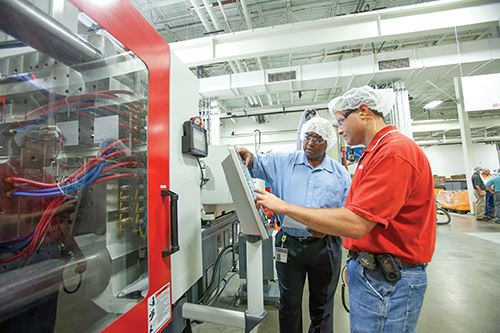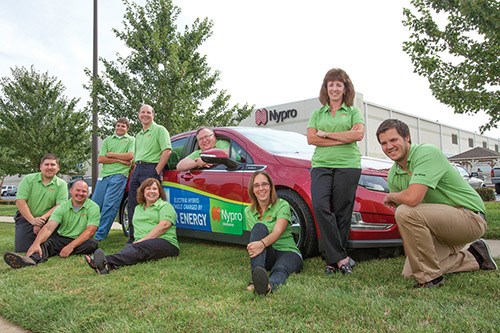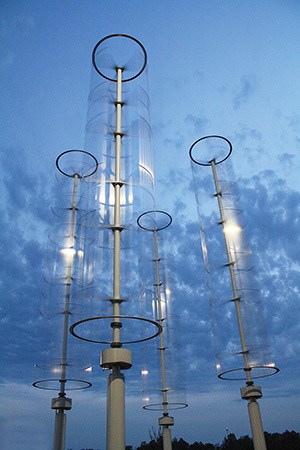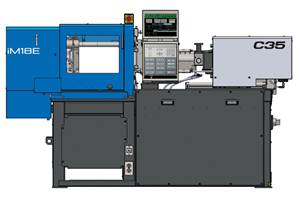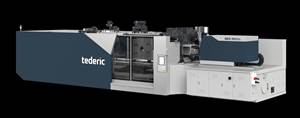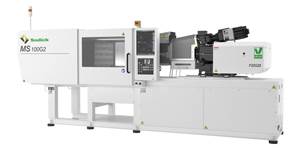Sustainable Medical Molding: For Nypro, It’s Good Business
Sustainability Series: Part Two
“Why worry about sustainability?” asks Ed Cathey, controller of Nypro’s Mebane, N.C., injection molding plant.
“Why worry about sustainability?” asks Ed Cathey, controller of Nypro’s Mebane, N.C., injection molding plant. At least four reasons jump to mind: “First, it’s the right thing to do, on many fronts.
“Second, it produces positive financial return, some of it short-term, some long-term.
“Third, it’s good customer relations. We got into ‘green’ on our own initiative at first, but nowadays large customers are pushing for it. In fact, three of our largest customers require it.
“Fourth, it can give you a competitive advantage in the marketplace.
“Fifth, it provides moral or political benefits within your local community.”
Nypro’s Mebane plant is only five years old, located in a 113,000-ft2 building originally designed as a warehouse. It employs 275 and houses 60 injection machines from 55 to 750 tons. The plant generates around $50 million of Nypro’s $1.2 billion total revenue. About 40% of Mebane’s business is medical cleanroom molding, and the rest is consumer packaging. Since 2010, the plant has been actively pursuing a number of sustainability initiatives, which Cathey enumerated in a session on “green molding” at the Molding 2013 Conference in New Orleans in January. Though Cathey provided instructive examples of sustainability in action, he offered these cautions, as well:
“There is simply no cookie-cutter approach to green manufacturing. Any approach needs to be right for you and your business. For example, do you have access to capital for a major investment that may take seven or more years to pay for itself? Does it make more sense for you to do a number of lower-cost projects that will excite your employees, suppliers, customers, and community?”
And with regard to ROI payback, he offered this advice: “While returns are very important, you can’t base your major green projects solely on your average business model’s ROI. You will eventually need to take a leap of faith that there are many more advantages to sustainability.”
GREEN TEAMS
Cathey says one of the keys to a successful sustainability program or initiative is to “involve all levels of your organization—down to the machine operators.” They should form a volunteer team of six to 12 members, who will meet at least monthly. You will also need an interested and motivated volunteer leader in your plant, but it also helps to have a full-time corporate-level sustainability leader. Top management must be willing to give financial and moral support to the sustainability program and should encourage and support education and training in “green” concepts.
Nypro Mebane formed a Sustainability Council of about a dozen members from every level of plant operations. They meet at least monthly to discuss progress on on two dozen open projects, small and large, at any given time.
One key activity for any plant’s sustainability team, Cathey advises, is to take the time to investigate available government and utility company incentives for “green” programs. The Mebane plant took advantage of such programs in implementing two types of renewable energy generation—solar and wind. As pictured on the cover of this issue, Nypro Mebane installed a $1 million, 0.25-megaWatt solar photovoltaic system on its roof, which went “live” in May 2010. “Our cost of electricity from Duke Energy is 6¢/kWh. In peak months, Duke pays us 12¢/kWh for our solar power. That generates about $40,000 a year in green energy.” With that revenue plus federal and state incentives, he adds, payback for the solar system is about six years. The system should last up to 25 years.
Government incentives stand to repay about 85% of the $1 million initial cost. The federal government reimbursed half of the initial cost in one year, while the state of North Carolina will pay up to 35% of the cost over five years.
Similar incentives apply to the installation of a $60,000, 6-kW wind energy system in May 2010. This generates about $4000 a year in green energy and will pay back within five years, limited mainly by the state’s 5-yr payout program.
All told, these renewable energy projects defray only a fraction of the plant’s energy bill, which amounts to $100,000 a month.
In addition, Nypro has worked to reduce energy consumption inside the Meban plant. In 2010, the original metal halide, warehouse-type lighting was replaced with high-efficiency fluorescents for $47,000. The result was both energy savings and a safer and more productive workplace with better illumination. Payback is estimated at two years.
In the last three years, the Mebane facility replaced 22 of the plant’s injection presses (165 to 750 tons) with energy-saving all-electric models from Milacron, Netstal, and Engel. “Based on our experience,” Cathey says, “I can’t imagine a better investment for a molder than moving to all-electric machines, versus hydraulic or hybrid. We have found energy demand for electric presses can be as much as 50% lower than for hydraulics. Depending on press size and kWh rate, that can save $3000 to $15,000 a year per press.”
Beyond energy savings, Cathey says, “Electric machines are cleaner—less oil, etc.—therefore they work well in all environments, especially medical molding. In our experience, repair and maintenance costs and downtime are lower, too. And there is potential for government and utility company incentives to help pay for them.
“The key point is that when you are in the market for a new press, the green investment in an electric machine is virtually zero, since the press will end up costing no more, and possibly a lot less, than a hydraulic press.” Cathey plans to take his own advice, since Nypro is considering doubling the size of the Mebane plant, creating an opportunity to purchase several new all-electric machines.
CURRENT SUSTAINABILITY PROJECTS
One of the next big “green” projects at Mebane may be to recycle rainwater from the plant roof to its cooling towers. It would involve installing a large tank to collect the rainwater. The proposed expansion would add another 80,000 ft2 of roof that would catch a lot more usable cooling water.
Other plans in the works to increase sustainability at Mebane include these:
•Reduce energy use further by installing thermal blankets on machine barrels, plus ceramic heater bands, variable-speed drives on hydraulic pumps, and energy-monitoring software.
•Reach zero waste sent to landfill. That involves recycling all plastic manufacturing scrap, as well as cardboard, wood, oils, and cleaning supplies. A concurrent goal is to reduce or eliminate all junk mail sent to the plant. Also, disposable earplugs will be replaced with permanent types.
•Save paper and ink by moving suppliers to electronic invoicing and payments, as well as implementing electronic batch records. A concurrent effort will reduce or eliminate individual inkjet printers.
•Installing warehouse air curtains will help minimizing heat losses.
•The plant will seek LEED building certification. LEED stands for Leadership in Energy and Environmental Design, a certification program of the U.S. Green Building Council.
Related Content
Compact Hybrid Injection Molding Machine Launched
Sumitomo Heavy Industries Ltd. (SHI) has introduced the iM18E, promising the smallest footprint in 20-ton machines.
Read MoreTederic Promotes High Technology, Broader Market Presence
Four cells are running in its booth including a 1,300-ton multimaterial system highlighting its 2K capabilities.
Read MoreNext-Generation All-Electric and Vertical Injection Molding Machines
Sodick Plustech’s VR-G and MS-G2 Series both utilize the company’s proprietary V-Line technology, separating plasticizing and injection functions, and have upgraded displays, energy efficiency, response time and more.
Read MoreLS Mtron’s Outsized NPE2024 Presence Jump-Starts Ambitious North American Market Goals
The Korean maker of injection molding machines featured eight machines in its nearly 14,000-square-foot booth with additional presses at Yushin and Incoe’s booths, as it targets 20% market share.
Read MoreRead Next
Lead the Conversation, Change the Conversation
Coverage of single-use plastics can be both misleading and demoralizing. Here are 10 tips for changing the perception of the plastics industry at your company and in your community.
Read MoreMaking the Circular Economy a Reality
Driven by brand owner demands and new worldwide legislation, the entire supply chain is working toward the shift to circularity, with some evidence the circular economy has already begun.
Read MorePeople 4.0 – How to Get Buy-In from Your Staff for Industry 4.0 Systems
Implementing a production monitoring system as the foundation of a ‘smart factory’ is about integrating people with new technology as much as it is about integrating machines and computers. Here are tips from a company that has gone through the process.
Read More

